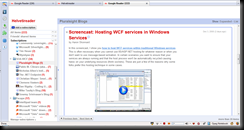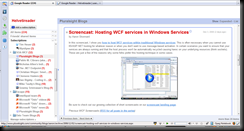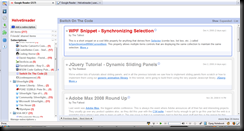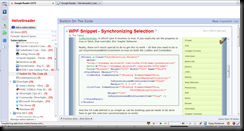First post in a while but I’m hoping to find time over the next few weeks to write about some of the things I’ve been up to lately including working with Silverlight, MVC and some good ‘old-fashioned’ .NET 3.5. Next post will be on my experiences with the possibilities (and the steep learning curve) given by the Microsoft Oslo platform.
Since it’s a Friday I thought I would put up a quick post inspired by the new look Google Reader released today with details on the official blog. I thought I would go my own way with the Helvetireader theme (using GreaseMonkey to support the scipt) for now and I like the streamlined, clean approach…
However, it’s clear that some real estate was being wasted so I changed tack and chose to use the standalone Helvetireader CSS with Stylish to allow me to tweak it slightly:
- Changed the max width so that there is no whitespace when reading with the subscriptions panel open
.entry .entry-body, .entry .entry-title {
max-width:1000px;
} - Removed the post entry options background images as this was overlapped by the options themselves when the Preview function was in place
This gave a good result..
The tweaked CSS can be found here.
The good thing about using either a GreaseMonkey script or a Stylish theme is that I can preserve the great functions offered by Better GReader, an essential Firefox extension which I have been using for some time. It looks like the Preview post function is not working in the latest version (v0.4). I reinstated this by installing the GreaseMonkey script provided by Julien Carosi at userscripts.org (making the changes given in a comment on the script).
This function is great as it enables you to stay within Google Reader while viewing the blog as it appears in its original form, either to view/post comments or read the entire post if the blogger has only provided a snippet/teaser via RSS.
To be honest, this practice annoys me and others. It would be understandble if this was the only way to provide marketing content but blogs such as Los Techies have proved otherwise. Luckily, with technical/development blogs, ‘after the jump’ syndrome is relatively rare perhaps due to the tech bloggers being keen consumers of syndicated content.




